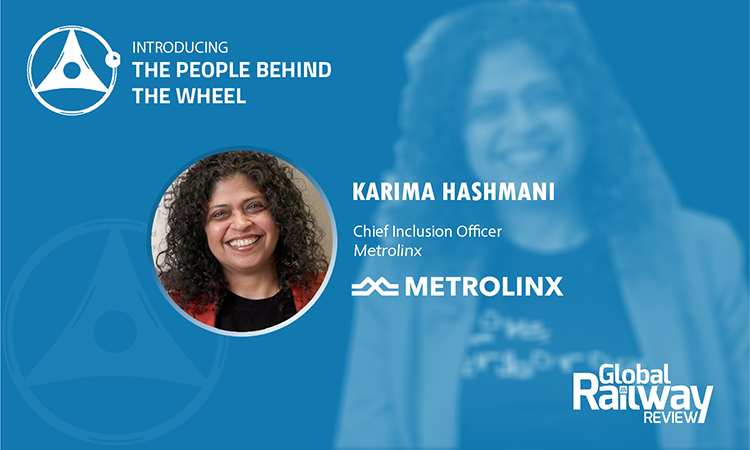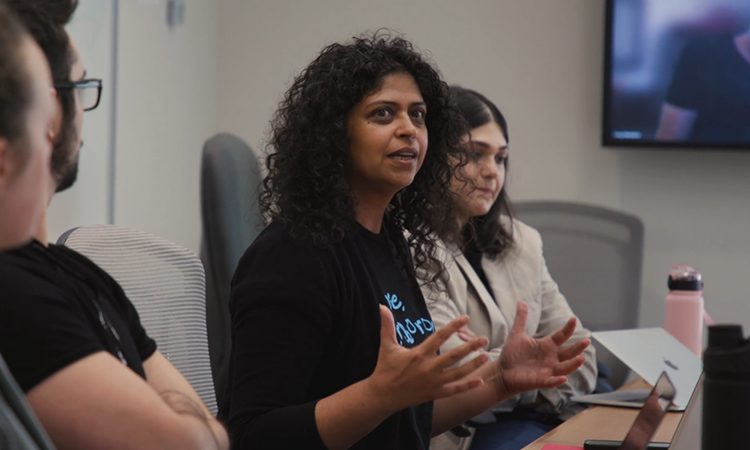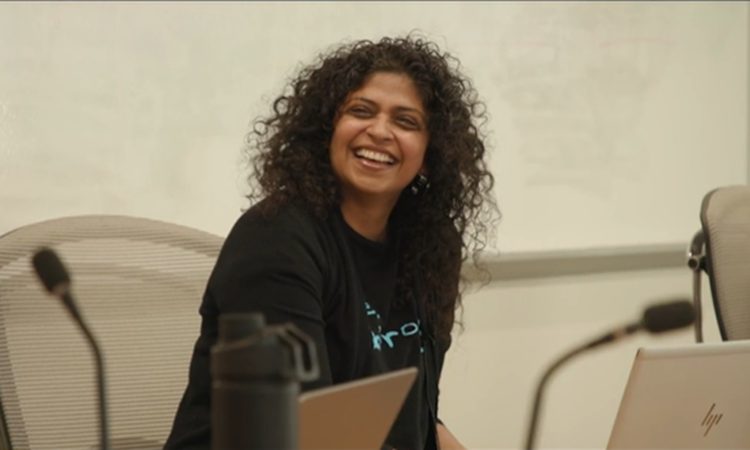The people behind the wheel: Karima Hashmani’s story, Metrolinx
Posted: 16 July 2024 | Karima Hashmani - Metrolinx | No comments yet
For the latest instalment of Global Railway Review’s ‘The people behind the wheel’ series, Karima Hashmani, Chief Inclusion Officer at Metrolinx, provides insight into her pivotal role in fostering equity, diversity and inclusion within one of Canada’s largest transit agencies, shaping a more inclusive future for both employees and passengers alike.


Can you tell us a bit about your role at Metrolinx?
I am the Chief Inclusion Officer at Metrolinx, a transit agency in the greater Toronto region. This is a new role for the organisation that reports directly to the CEO, establishing equity, diversity and inclusion (EDI) as a priority at the senior leadership level.
I oversee a team that is dedicated to driving employee engagement and EDI for our employees, customers and communities”
Metrolinx operates commuter bus and rail services, oversees a dedicated rail service to and from Toronto’s international airport to downtown Toronto, and has a mandate to build new subway routes and light rail transit. I oversee a team that is dedicated to driving employee engagement and EDI for our employees, customers and communities.
A key competency for all employees at Metrolinx is continuous improvement and all employees are required to take training and apply this approach in their work. With this mindset, we can better identify, address and remove barriers, avoid, or mitigate risks and strengthen our organisational culture while driving better business outcomes.
I see the role and mandate of the Office of the Chief Inclusion Officer as another way of continually improving our organisation and providing a better experience for our customers and employees.
What inspired you to seek a career in the transport industry?
I know how critical it is to have access to safe and affordable transit to get you from one place to another”
First, I have always been inspired to work in industries that align with my values. Throughout my career, there has been a common thread of service and equity, whether it be in post-secondary education, social housing or now in transit.
Transit has played a big role in my life. Growing up in the east end of Toronto, I was dependent on public transit to get me to and from school, connect me to part-time jobs across the city and to family and friends. I know how critical it is to have access to safe and affordable transit to get you from one place to another.
What drew me to my current role was Metrolinx’s mission to ‘connect communities.’ As an organisation operating in one of the most diverse regions in Canada that is committed to meaningful engagement and partnering with communities, I was excited to be able to contribute and support Metrolinx in its efforts to be an equitable, inclusive and engaged organisation.
Have you experienced any challenges in your role and, if yes, how have you overcome them?
I’ve learned that everyone has a different level of awareness and understanding. My approach has always been to meet people where they are in their journey because culture shifts take time and require intentionality”
As a woman of colour from an immigrant family, and a mum of two kids, it is common to experience challenges in the workplace, especially working in EDI. As an example, engaging in conversations about religious holidays and accommodations, or flexibility in the workplace so parents can take their kids to school or day-care, is now the norm but it wasn’t in the past.
Thankfully, I’ve seen a shift in workplace culture throughout my career where equity, diversity and inclusion are now being incorporated into practices, processes and initiatives. I’ve learned that everyone has a different level of awareness and understanding. My approach has always been to meet people where they are in their journey because culture shifts take time and require intentionality.


Credit: Metrolinx
I’ve also learned data speaks volumes and sharing best practices is essential. One goal Metrolinx had was better understanding the inclusion experience of our employees through insights from equity deserving communities. It has been a priority for us to expand data insights and inclusion metrics in our annual employee engagement survey. This data gives our organisation greater clarity on where we should focus our efforts and the actions required to ensure all employees feel valued, respected and heard.
Seeing our progress in creating an equitable, inclusive and engaged workplace keeps me inspired and motivates me to continue this important work.
What would be the top three highlights of your career in the industry to date?
There have been several highlights in my career in transit to date. Among them: working as Metrolinx’s first Chief Inclusion Officer and supporting the organisation in building a culture where people feel seen, heard and valued. In this role, I get to engage with colleagues and partners from across our operations who are passionate about making things better through our systems, processes and practices.
Another highlight is delivering the organisation’s first equity, diversity and inclusion strategy in 2022. The strategy was developed in 2023 in consultation with people across the organisation, including our frontline staff and employee resource groups, leadership and partners. The strategy is a significant milestone for Metrolinx and is a tangible commitment to meaningful and positive cultural change.
Finally, I love working in Toronto’s historic Union Station where over 300,000 customers pass through daily from communities across the region and around the world. After years of commuting, I can jump on a GO train to an event downtown and hear from fellow travellers whether they are newcomers to Canada, students or folks travelling to and from work. Seeing customers light up when they see themselves represented on our trains, like when we had a Diwali-themed train, was a highlight this year.
What key pieces of advice would you give to someone who is interested in a career in rail?
My advice to anyone interested in a career in rail or transit is to look for a workplace culture where you will be supported and valued. Listen to how others speak about the organisation”
A career in rail or transit is deeply rewarding. There are many opportunities to make a difference – whether in operations, communications, community engagement, safety, finance, legal, or risk management. Across the industry, we are seeing that representation of equity-deserving communities is growing.
My advice to anyone interested in a career in rail or transit is to look for a workplace culture where you will be supported and valued. Listen to how others speak about the organisation. Check the profiles of leaders on LinkedIn and, if applicable, watch virtual general meetings. Do the organisation’s commitments and actions align with your values? If so, connect and meet with individuals to find out more. You may be surprised to learn how much this industry has to offer.
Wherever you land, my advice is to proactively contribute to building a more equitable and inclusive workplace. Take the opportunity to learn and network with colleagues within and outside your team. Employee resource groups offer great opportunities to connect and build community with others. Don’t be afraid to ask questions and share your lived experiences to contribute to change in an organisation. Be inclusive in your approach and understand your biases – we are all continuously learning.


Credit: Metrolinx
How do you see innovation shaping your role and the rail industry in the next five years?
I believe that being innovative is essential for shaping this role and the industry overall.
Being aware of, and addressing, these issues requires a multifaceted approach to ensure bias, discrimination and equity is considered and we have accountable practices”
Artificial intelligence (AI) is a hot topic right now because it has the potential to revolutionise the industry from enhancing safety, to minimising our environmental footprint, to optimising our services. AI’s potential is exciting, and I believe we’ve barely scratched the surface when it comes to application. That said, equity professionals are also seeing the potential for issues if not approached with care.
Being aware of, and addressing, these issues requires a multifaceted approach to ensure bias, discrimination and equity is considered and we have accountable practices. Interestingly, there are intersections between my role and the industry in this way. Our organisation has created a cross-divisional AI committee to help guide us and I am happy to contribute to that effort.
I also see a lot of alignment between my role’s mandate and the role of innovation in shaping the practices of our industry. The intention of both is to ultimately work for the betterment of the organisation and the people we serve by identifying and mitigating barriers, driving efficiencies and striving towards a more equitable and inclusive experience for customers and employees alike.
In an ideal world, how do you envision the future of rail evolving?
My ideal world is one where equity, diversity and inclusion is embedded in all facets of the industry. A world where everyone has a shared responsibility in designing all initiatives equitably and inclusively”
My ideal world is one where equity, diversity and inclusion is embedded in all facets of the industry. A world where everyone has a shared responsibility in designing all initiatives equitably and inclusively.
At Metrolinx, we have begun intentionally incorporating an equity lens into our work. My hope is our equity lens tool becomes a standard part of future initiatives with all employees incorporating it into their work plans. This initiative will help teams proactively develop effective and equitable policies or programmes at the outset, rather than retrofitting or reworking an initiative after it’s launched.
The purpose of this tool is to provide guidance on identifying barriers and unintended equity impacts, while offering guidelines to modify initiatives in a manner that prevents negative impacts or worsening of existing disparities.
The Equity Lens Tool follows a structured six-step method, ensuring that equity is embedded at every stage of the decision-making process. We have included a set of questions applicable across various work areas, from communications, marketing, recruitment and construction to service planning, and more.
This approach drives informed decision-making, promotes understanding and accountability, as well as mitigates risks by embedding EDI considerations into the early stages of projects and initiatives. I am excited for the journey Metrolinx is on.









